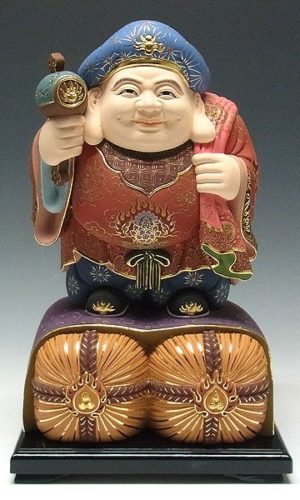
大黒天(摩利支天と同一種子)
梵名をマハーカーラといい、「大いなる暗黒」との意味があります。
わが国では七福神の一つに数えられ、頭巾をかぶり、大きな袋を背負い、右手に打出の小槌を待った姿で親しまれています。
しかし、本来は、シヴア神の化身とされ、戦闘をつかさどるほか、冥府の神ともされています。
仏教では施福の神として寺院の台所にまつられ、僧侶たちが食べ物の心配をしないで修行に励かことができるように、必要なものが手にはいるように寺院を守護します。
大黒天を食厨の柱にまつったところから、家をささえる最も太い柱や一家のあるじを「大黒柱」というようになりました。一般には福徳の神として、商売繁昌など
ます。おん ま ら か きや や そわ か
日本には密教の伝来とともに伝わり、天部と言われる仏教の守護神達の一人で、軍神・戦闘神、富貴爵禄の神とされたが、特に中国においてマハーカーラの3つの性格のうち、財福を強調して祀られたものが、日本に伝えられた。密教を通じて伝来したことから初期には主に真言宗や天台宗で信仰された。インドでも厨房・食堂の神ともされていたが、日本においては最澄が毘沙門天・弁才天と合体した三面大黒を比叡山延暦寺の台所の守護神として祀ったのが始まりという。後に大国主神と習合した。室町時代になると日蓮宗においても盛んに信仰された。「大黒さん」として親しまれている。
袋を背負っているのは、大国主が日本神話で最初に登場する因幡の白兎の説話において、八十神たちの荷物を入れた袋を持っていたためである。また、大国主がスサノオの計略によって焼き殺されそうになった時に鼠が助けたという説話(大国主の神話#根の国訪問を参照)から、鼠が大黒天の使いであるとされる。
シヴァ([ˈʃivə]; サンスクリット: शिव, Śiva、「吉祥者」の意)はヒンドゥー教の神である。現代のヒンドゥー教では最も影響力を持つ3柱の主神の中の1人であり、特にシヴァ派では最高神に位置付けられている[1][2]。
トリムルティ(ヒンドゥーの理論の1つ)ではシヴァは「破壊/再生」を司る様相であり、ブラフマー、ヴィシュヌとともに3柱の重要な神の中の1人として扱われている[3][4]。また、シヴァ派では世界の創造、維持、再生を司る最高神として位置づけられている[5][6][7]。デーヴィ(ヒンドゥーの女神)らを重視するシャクティ派では女神らが最高神として位置づけられている一方で、シヴァもヴィシュヌ、ブラフマーとともに崇拝の対象となっている。このシャクティ派では女神らがシヴァやそれぞれの神の根源であると考えられており、パールヴァティー(女神)がシヴァに対応する相互補完的なパートナーであるとされている[8][9]。スマールタ派のパンチャヤタナ・プージャ(英語版)(儀式)ではシヴァは礼拝の対象となる5柱の中の1人に数えられる[1]。
最も賞揚される文脈では、シヴァは形の無い、無限の、超越的な、不変絶対のブラフマンであり[10]、同時に世界の根源的なアートマン(自我、魂)であると語られる[11][12][5]。シヴァに関する神話では慈悲深い様を示す描写がある一方で、対照的に恐ろしい性質を見せるエピソードも多く語られ、曖昧さとパラドックスの神などとも表現される[13]。また、アディヨーギー・シヴァ(Adiyogi、第一の修行者)とも呼ばれ、ヨーガ、瞑想、芸術の守護神でもある[14][15][16]。
偶像上のシヴァの特徴としては、額の第三の目(英語版)、首に巻かれた蛇、三日月の装飾具、絡まる髪の毛から流れるガンジス川、武器であるトリシューラ(三叉の槍)、ダマル(英語版)(太鼓)が挙げられる。シヴァは通常リンガという形に象徴化され信仰される[17]。また、シヴァは地域によらずインド、ネパール、スリランカなど全土で信仰されている

Daikokuten (same seed as Marici)
The name of Sanskrit is Mahakala, which means “great darkness.”
In Japan, it is counted as one of the Seven Lucky Gods, and is familiar with wearing a hood, carrying a large bag on its back, and waiting for a gavel to be launched in the right hand.
However, originally, it is considered to be the incarnation of Shiva, who is in charge of battle and is also the god of the Netherworld.
In Buddhism, the god of blessing is enshrined in the temple kitchen and protects the temple so that the monks can get what they need so that they can practice without worrying about food.
From the place where Daikokuten was wrapped around the pillars of the food kitchen, the thickest pillars that support the house and the pillars of the family came to be called “Daikokuten”. Generally, as a god of good fortune, business prosperity, etc.
I will. Onmaraka Kiya or Sowaka
It was introduced to Japan with the introduction of esoteric Buddhism, and was one of the guardian gods of Buddhism called Tenbe, and was regarded as a god of war, a battle god, and a god of wealth, but especially in China, among the three characteristics of Mahakala, fortune What was emphasized and enshrined was passed on to Japan. Since it was introduced through esoteric Buddhism, it was worshiped mainly in the Shingon sect and Tendai sect in the early days. In India, it was also regarded as the god of kitchens and restaurants, but in Japan, Saicho enshrined Sanmen Daikoku, which was united with Bishamonten and Benzaiten, as the guardian deity of the kitchen of Hieizan Enryakuji Temple. Later, he learned from Okuninushi. In the Muromachi period, it was widely worshiped in the Nichiren sect. It is popular as “Mr. Daikoku”.
The reason for carrying the bag is that Okuninushi carried a bag containing the luggage of the eighty gods in the tale of Inaba’s white rabbit, which first appeared in Japanese mythology. Also, from the tale that the mouse helped when the Okuninushi was about to be burned down by Susanoo’s scheme (see Okuninushi’s Myth #Visit to Ne-no-kuni), it is said that the mouse is the messenger of Daikokuten.
Shiva ([ˈʃivə]; Sanskrit: शिव, Śiva, meaning “auspicious”) is a Hindu god. It is one of the three most influential main gods in modern Hinduism, and is positioned as the supreme deity, especially in the Shaivists. [1] [2]
In Trimurti (one of the Hindu theories), Shiva is in charge of “destruction / regeneration” and is treated as one of the three important gods along with Brahma and Vishnu [3] [4]. Also, in the Shaivists, it is positioned as the supreme deity that controls the creation, maintenance, and regeneration of the world [5] [6] [7]. While the Shaktists who emphasize Davi (the goddess of Hinduism) and others are positioned as the supreme deities, Shiva is also the object of worship along with Vishnu and Brahma. In this Shaktism, the goddesses are considered to be the roots of Shiva and their respective gods, and Parvati (goddess) is considered to be a complementary partner to Shiva [8] [9]. In the Smarta tradition of Panchayatana Puja (ritual), Shiva is one of the five pillars of worship. [1]
In the most exalted context, Shiva is said to be an infinite, infinite, transcendental, immutable Brahman [10] and at the same time the fundamental Atman (ego, soul) of the world [11]. [12] [5]. While the myths about Shiva have depictions of benevolence, many episodes show terrifying qualities in contrast, and are also described as the god of ambiguity and paradox. [13] Also known as Adiyogi (first practitioner), he is also the guardian deity of yoga, meditation, and art [14] [15] [16].
The features of Shiva on the idol are the third eye on the forehead, the snake wrapped around the neck, the crescent decoration, the Ganges river flowing from the entwined hair, the weapon Trishula, and Damaru. (English version) (Taiko) can be mentioned. Shiva is usually symbolized and worshiped in the form of a lingam. [17] In addition, Shiva is worshiped throughout India, Nepal, Sri Lanka, etc., regardless of region. [18] [19]
